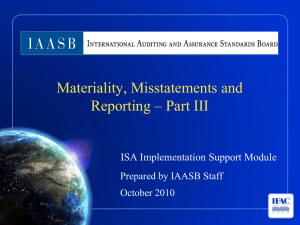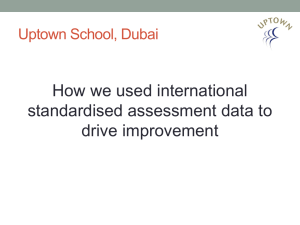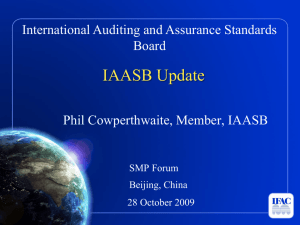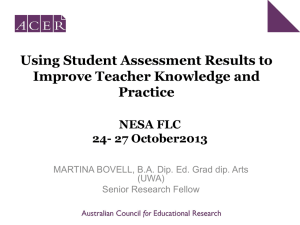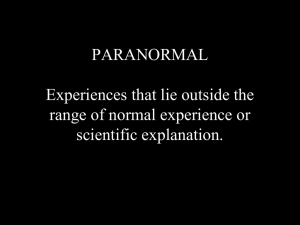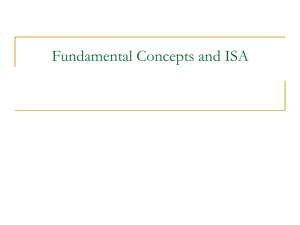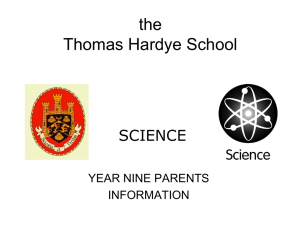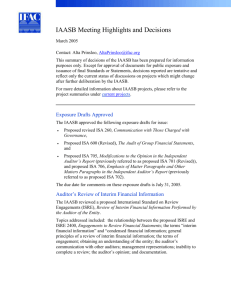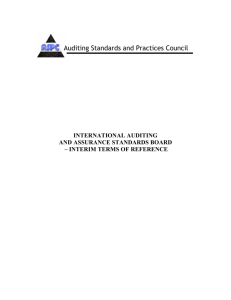IAASB`s Role, Objectives and Structure
advertisement
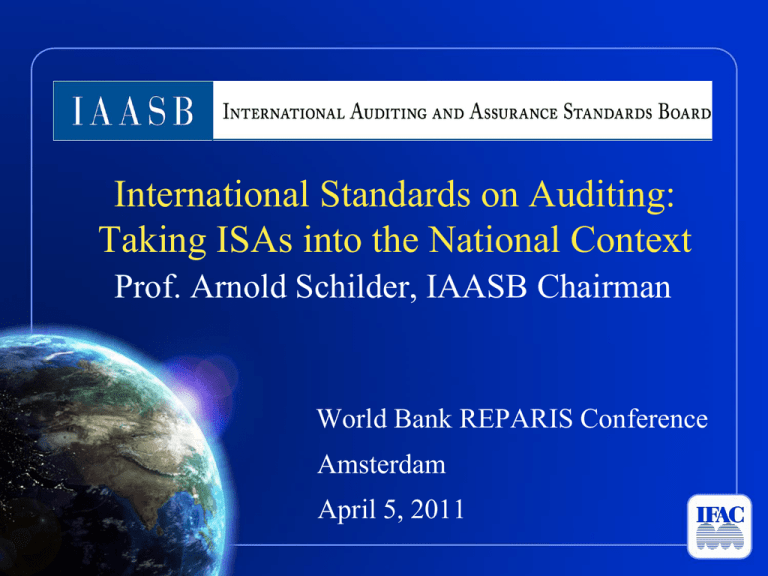
International Standards on Auditing: Taking ISAs into the National Context Prof. Arnold Schilder, IAASB Chairman World Bank REPARIS Conference Amsterdam April 5, 2011 IAASB’s Role, Objectives and Structure Role and Objectives of the IAASB • Independent standard-setting board that serves the public interest by: – Setting high-quality standards dealing with auditing, review, other assurance, quality control and related services – Facilitating the convergence of national and international standards • Contributes to enhanced audit quality throughout the world, and strengthened public confidence in financial reporting 2 IAASB’s Role, Objectives and Structure IAASB Structure and Standard-Setting Process • IAASB: – Meets for a full week, four times per year – Broad-based membership: 17 members, full-time Chair, Technical Advisors and three permanent observers with speaking rights • Consultative Advisory Group – Meets twice per year, 30 Member Organizations • Standard-Setting Process – Global consultation, transparent due process, open meetings and oversight via the International Public Interest Oversight Board (PIOB) 3 IAASB’s Role, Objectives and Structure Developing High-Quality Pronouncements • Rigorous and transparent due process – Protects public interest and ensures global acceptance • Global consultation and responsiveness – Dialogue with key stakeholders National auditing standard-setters Basel Committee, EC, Financial Stability Board, IAIS, IFIAR, IOSCO, World Bank Investors and preparers (via IAASB CAG and outreach) Other key stakeholders: IASB, FEE, Forum of Firms, ICGN, IFAC member bodies, PCAOB 4 IAASB’s Role, Objectives and Structure Developing High-Quality Pronouncements • International Standards on Auditing (ISAs) • International Standards on Assurance Engagements (ISAEs) • International Standards on Review Engagements (ISREs) • International Standards on Related Services (ISRSs) • International Auditing Practice Statements (IAPSs) 5 Clarified ISAs The Clarified ISAs • A significant development in auditing standards internationally • Redrafting of 36 ISAs and ISQC 1 • Greater clarity, understandability and consistency of application – New structure, conventions and obligations • Half of the ISAs fundamentally revised – Strengthen the ‘thinking audit’ – Enhanced quality of performance in many areas • Now effective! (from 2010 calendar year audits) • Minimum 2 year moratorium on new standards 6 Clarified ISAs ISAs General Principles and Responsibilities Risk Assessment and Response to Assessed Risks ISA 200 ISA 300 ISA 500 ISA 600 ISA 700 ISA 800 ISA 210 ISA 315 ISA 501 ISA 610 ISA 705 ISA 805 ISA 220 ISA 320 ISA 505 ISA 620 ISA 706 ISA 810 ISA 230 ISA 330 ISA 510 ISA 710 ISA 240 ISA 402 ISA 520 ISA 720 ISA 250 ISA 450 ISA 530 Audit Evidence ISA 260 ISA 540 ISA 265 ISA 550 ISA 560 Using Work of Others Audit Conclusions and Reporting Specialized Areas Clarity Project: Legend New Revised and Redrafted ISA 570 Redrafted only ISA 580 Post Clarity (2009 → ) revision of ISAs 610 and 720 7 7 Clarified ISAs Key Changes from the Clarity Project • Principles-based and emphasize the use of professional judgment and professional skepticism • More robust featuring strengthened requirements in key areas: – Risk assessment (e.g., estimates and related parties) – Materiality and its use in evaluating misstatements – Audit evidence (e.g., confirmations and representations) – Using the work of others (e.g., group audits and experts) – Auditor reporting and communications (including with those charged with governance) 8 Clarified ISAs Global Auditing Standards: Where Are We Now? Expressed support for Clarified ISAs: • • • • • • • International Organization of Securities Commissions (IOSCO) Basel Committee on Banking Supervision Financial Stability Board International Organization of Supreme Audit Institutions (INTOSAI) United Nations Conference on Trade and Development (UNCTAD) World Bank World Federation of Exchanges Other uses of Clarified ISAs globally: • INTOSAI Congress (INCOSAI) through International Standards of Supreme Audit Institutions (ISSAIs) • Top 22 global auditing networks’ methodologies align 9 Clarified ISAs Global Auditing Standards: Where Are We Now? Countries Using Clarified ISAs already, or Committed to Using them in the near future: Europe: Albania, Belgium, Bulgaria, Croatia, Cyprus, Czech Republic, Denmark, Estonia, Finland, Georgia, Greece, Hungary, Iceland, Ireland, Kosovo, Latvia, Lithuania, Malta, Netherlands, Norway, Serbia, Slovakia, Slovenia, Sweden, Switzerland, Turkey, United Kingdom Asia/ Pacific: Australia, Bangladesh, China, Hong Kong, India, Japan, Kazakhstan, Malaysia, Mongolia, Nepal, New Zealand, Pakistan, Philippines, Singapore, South Korea, Sri Lanka, Americas: Brazil, Canada, Guatemala, Guyana, Mexico, Nicaragua, Panama, Trinidad and Tobago, USA (private companies) Africa/ Middle East: Botswana, Kenya, Lebanon, Lesotho, Malawi, Mauritius, Namibia, South Africa, Swaziland, Tanzania, Tunisia, Uganda, United Arab Emirates (Abu Dhabi and Dubai), Zambia, Zimbabwe 10 Adoption and Implementation into the National Context EC Green Paper – ISA Adoption • Support for ISA Adoption – Support from Professional Bodies, Firms, Public Authorities, Academics, Investors; mixed views preparers/companies • Impact on SMEs/SMPs: “We must first avoid causing SMEs and small and medium audit firms additional cost …” – IFAC’s “An Audit is an Audit” well-understood; IAASB Staff Publication on proportionality often quoted; SMP Committee Implementation Guides important; EDs for reviews/compilations: may be used by audit-exempt entities • Governance: Need to emphasize independence, due process, transparency of the standard-setting process – Governance and nominations; public interest; Investor participation – how can this be strengthened? 11 Adoption and Implementation into the National Context Relationship with Audit Regulators • Dialogue between IAASB and audit regulators important: – Interpretation of standards; importance of professional judgment – Proportionate audit documentation – Learning from inspections findings • Regular contact between IAASB and IFIAR – Plenary, working groups, ad hoc meetings • Europe: from EGAOB to European Audit Inspection Group – First meeting IAASB-EAIG June 2011 (and ad hoc) 12 12 Adoption and Implementation into the National Context Key Success Factors • Effective implementation key to realizing full benefits • Need to fully adopt ISAs including relevant pronouncements; ISQC 1, Code of Ethics for Professional Accountants • Understand and communicate how ISAs can be applied proportionately to the size and complexity of the entity – Projects to assist SMEs/SMPs; Reviews and Compilations • Practical implementation challenges not underestimated – Education/training; audit methodologies; monitoring and enforcement 13 Adoption and Implementation into the National Context Implementation of Clarified ISAs • IAASB support – IAASB Clarity Center (http://web.ifac.org/claritycenter/index) – ISA modules (11 videos + slide packs re revised ISAs) – IAASB Staff Alerts, Q&A and FAQs – Clarity ISA Modules – Implementation Monitoring Project • IFAC SMP Committee: – ISAs and Quality Control Guides – IFAC Translation support 14 “Robust audit is key to re-establishing trust and market confidence; it contributes to investor protection and reduces the cost of capital for companies” EC Green Paper, October 2010 15 http://www.iaasb.org
